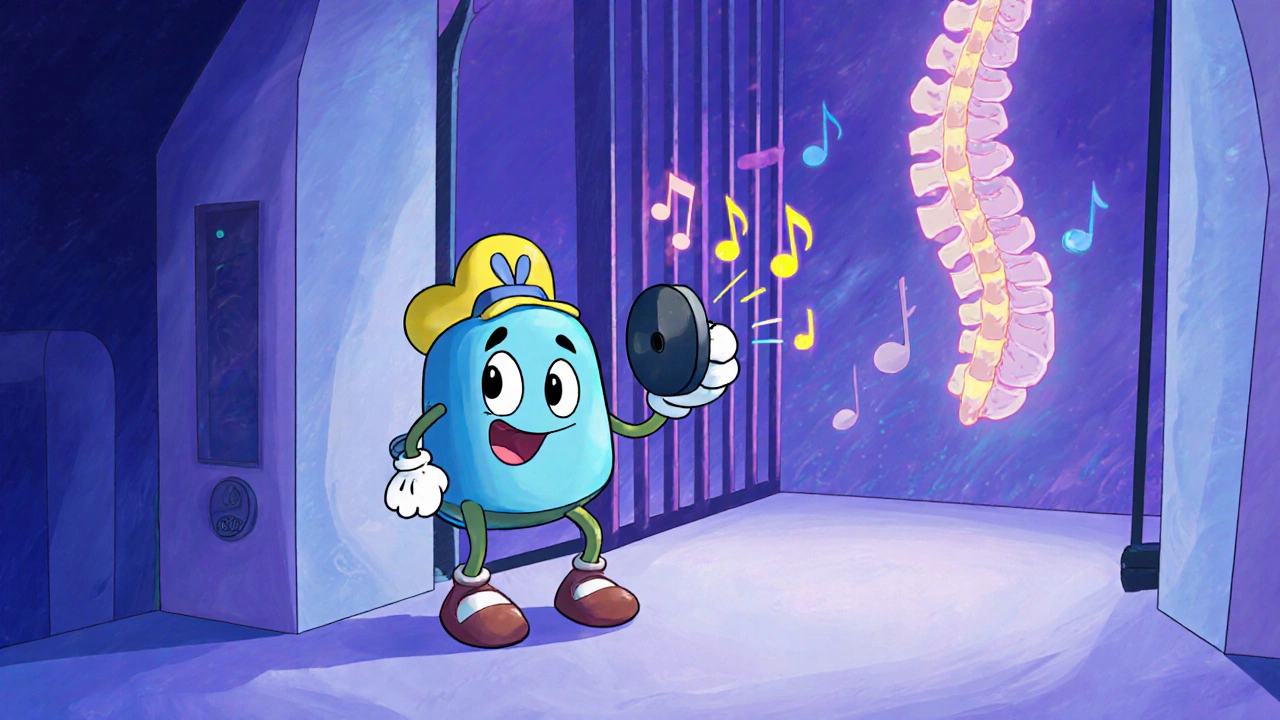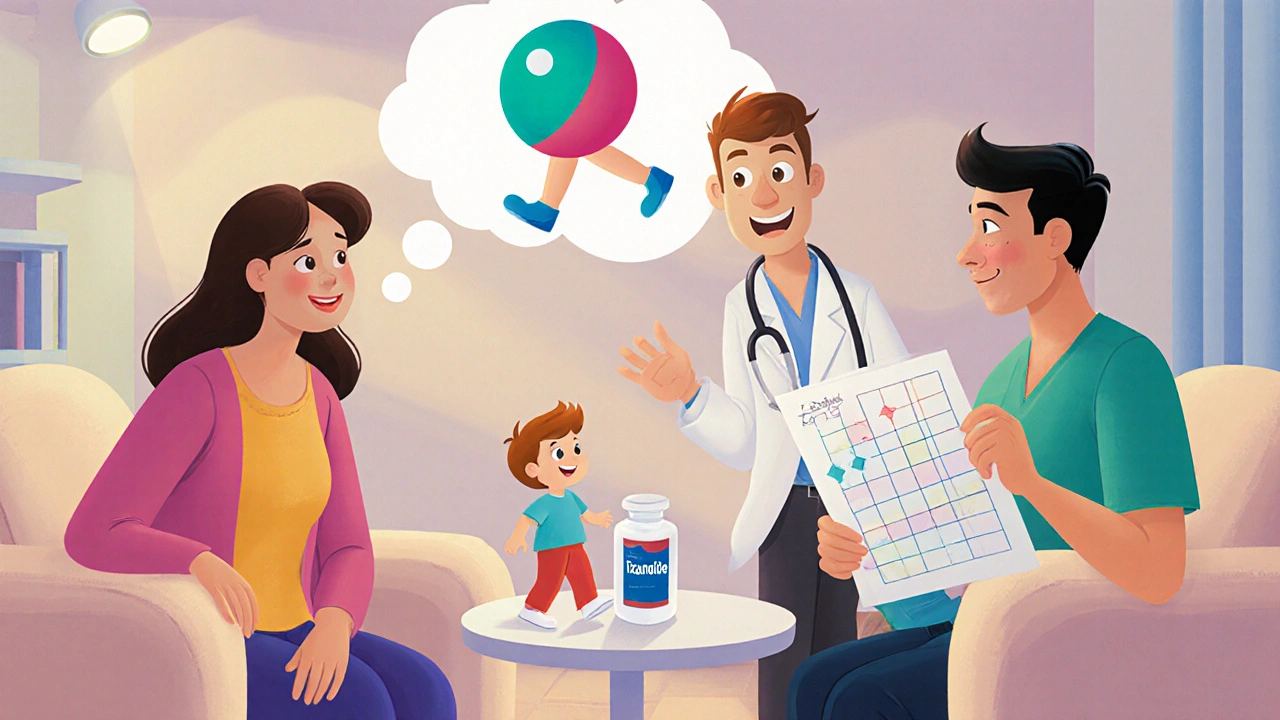Tizanidine Dosage Calculator for Cerebral Palsy
Dosage Calculator
Important Safety Notes
- Start with the lowest possible dose (0.5 mg) and increase slowly
- Monitor liver function (ALT/AST) before starting and regularly during treatment
- Do not stop suddenly - taper over 2-3 days
- Take with food to reduce stomach upset
- Adjust dose timing to minimize drowsiness (e.g., take highest dose at bedtime)
When a child with cerebral palsy (CP) struggles with tight, jerky muscles, daily life can feel like a constant battle. Tizanidine is a prescription muscle relaxant that many clinicians turn to for easing that spasticity. Below, we break down exactly how the drug works, when it shines, and what you need to watch out for.
What Is Cerebral Palsy?
Cerebral Palsy is a permanent movement disorder caused by brain injury or abnormal development before, during, or shortly after birth. It affects roughly 2‑3 per 1,000 live births in the UK and presents in several ways: spastic (stiff muscles), dyskinetic (involuntary movements), or ataxic (poor coordination). The most common form, spastic CP, accounts for about 80 % of cases and is the main target for medicines that reduce muscle tone. While therapy, orthotics, and surgery are staples of CP care, pharmacologic options like tizanidine can provide the extra muscle‑relaxing push needed to make rehab exercises bearable.
How Tizanidine Works - The Pharmacology Basics
Tizanidine belongs to the class of drugs called α2‑adrenergic agonists. It binds to α2 receptors in the spinal cord, dampening the release of excitatory neurotransmitters that normally fire motor neurons. Think of it as turning down the volume on a noisy speaker: the signal that tells muscles to contract gets quieter, so the muscles stay more relaxed.
- GABA‑mediated inhibition: By enhancing gamma‑aminobutyric acid (GABA) activity, tizanidine boosts the brain’s natural “brake” system.
- Rapid onset: Oral doses start to work within 30‑60 minutes, peaking around 2-3 hours.
- Short half‑life: About 2.5 hours, meaning the drug clears fairly quickly, which helps with dose titration.
These properties make tizanidine a good fit for children whose spasticity fluctuates throughout the day, allowing clinicians to fine‑tune dosing around school, therapy sessions, and sleep.
Clinical Evidence - Does It Really Help?
Several trials over the past decade have examined tizanidine in pediatric spasticity, often comparing it to baclofen or placebo. A 2022 double‑blind study involving 112 children with spastic CP showed a mean reduction of 18 % in the Modified Ashworth Scale (MAS) after 8 weeks of titrated tizanidine, without a significant increase in sedation compared to baclofen.
Key take‑aways from the evidence:
- Efficacy: Most studies report a 10‑20 % drop in spasticity scores, enough to improve gait and ease of dressing.
- Time to effect: Benefits often appear within 2-4 weeks of reaching a stable dose.
- Safety profile: Side effects are usually mild (dry mouth, drowsiness, hypotension), and serious liver toxicity is rare when liver function is monitored.
Real‑world reports from UK paediatric neurology clinics echo these numbers - children who add tizanidine to physiotherapy often achieve a smoother range of motion and can participate longer in therapy sessions.

Dosage and Administration - Getting the Numbers Right
Because children vary widely in weight and metabolism, starting low and going slow is the rule of thumb. Below is a typical titration schedule for a 20‑kg child:
- Day 1‑3: 0.5 mg orally once daily.
- Day 4‑7: Increase to 0.5 mg twice daily.
- Week 2 onward: Add 0.5 mg every 2‑3 days until reaching 2-4 mg three times daily, or until the desired spasticity reduction is achieved.
Maximum recommended dose for children is generally 6 mg/day, but some neurologists push to 8 mg in refractory cases with close liver‑function monitoring.
Key administration tips:
- Take with food to lessen stomach upset.
- Avoid abrupt discontinuation - taper over 2‑3 days to prevent rebound spasticity.
- Check liver enzymes (ALT, AST) before starting and every 3 months thereafter.
Comparing Tizanidine With Other Muscle Relaxants
| Drug | Class | Typical Pediatric Dose | Onset | Common Side Effects |
|---|---|---|---|---|
| Tizanidine | α2‑adrenergic agonist | 0.5‑6 mg/day | 30‑60 min | Drowsiness, dry mouth, hypotension |
| Baclofen | GABA‑B agonist | 5‑20 mg/day | 1‑2 hrs | Weakness, dizziness, constipation |
| Diazepam | Benzodiazepine | 0.12‑0.5 mg/kg/day | 15‑30 min | Sedation, dependence, respiratory depression |
| Botulinum toxin | Neurotoxin injection | 2‑6 U/kg per muscle | 3‑7 days | Local weakness, pain at injection site |
In practice, tizanidine often wins when you need a quick‑acting oral option with a short half‑life, making dose adjustments less cumbersome. Baclofen is useful for chronic, generalized tone but can cause more pronounced weakness. Diazepam provides fast relief but carries dependence risk, while botulinum toxin is great for focal spasticity but requires repeat injections.
Managing Side Effects - Pro Tips for Parents and Clinicians
Even though tizanidine is generally well‑tolerated, a few pitfalls pop up:
- Hypotension: Check blood pressure after each dose increase, especially if the child stands up quickly.
- Dry mouth: Encourage sipping water or using sugar‑free lozenges.
- Liver function: Baseline labs are mandatory; if ALT/AST rise >3× ULN, cut the dose by half or stop.
- Excessive drowsiness: Schedule doses so the higher amounts coincide with bedtime.
When side effects become troublesome, consider splitting the total daily dose into smaller, more frequent administrations or swapping to a lower‑potency agent like baclofen for a trial period.

Putting It All Together - A Practical Decision Flow
Below is a quick flowchart clinicians can use during a CP clinic visit:
- Assess spasticity severity (MAS score ≥ 2) and functional impact.
- Confirm that physiotherapy and orthotics are already optimized.
- If focal spasticity dominates → consider botulinum toxin.
- If generalized tone or mixed pattern → move to oral agents.
- Start tizanidine at low dose; monitor BP and liver enzymes.
- If side effects prevail → reduce dose or switch to baclofen.
- Re‑evaluate MAS and functional goals after 4‑6 weeks.
- Successful reduction → maintain dose.
- Insufficient response → consider combination therapy (e.g., tizanidine + oral baclofen) under specialist supervision.
This structured approach keeps families informed, reduces trial‑and‑error, and aligns medication choices with rehab goals.
Frequently Asked Questions
Can tizanidine be used in newborns with CP?
Evidence in neonates is limited. Most specialists wait until the infant is at least 6 months old and has a confirmed spasticity pattern before starting tizanidine, always with liver‑function monitoring.
How does tizanidine differ from oral baclofen?
Tizanidine works through α2‑adrenergic receptors, giving a quicker onset and a shorter half‑life, which makes dose tweaking easier. Baclofen acts on GABA‑B receptors, is longer‑acting, and may cause more generalized weakness.
What should I do if my child feels overly sleepy after a dose?
First, check the timing - shifting the dose to bedtime often solves the issue. If sleepiness persists, reduce the dose by 0.5 mg and reassess.
Is liver monitoring really necessary?
Yes. Although severe hepatotoxicity is rare, cases have been reported when doses exceed recommended limits or when the drug interacts with other hepatically‑metabolized medications.
Can tizanidine be combined with botulinum toxin?
Many clinicians use them together - botulinum toxin tackles focal spikes, while tizanidine smooths out the remaining generalized tone. Coordination between the neurologist and physiotherapist is key.
Bottom Line
For children with spastic cerebral palsy, tizanidine offers a fast‑acting, titratable option that can slot neatly into a broader rehab plan. Its main strengths are the quick onset, short half‑life, and relatively mild side‑effect profile when liver function is watched. Pair it with physiotherapy, orthotics, and, when needed, other pharmacologic tools, and you’ll often see a measurable drop in muscle tone, better mobility, and a happier family.

Comments
Sophia Lyateva
tizanidine? lol they just wanna drug up kids so they can stop paying for real therapy. i heard the gov is secretly testing this on disabled kids to see if they can make em docile for the system. 🤔
On October 25, 2025 AT 15:45
David Ross
This is a meticulously researched, clinically grounded overview-exactly what the medical community needs to stop the anecdotal nonsense. The pharmacokinetic breakdown is flawless, and the dosing table? Perfect. I’ve seen too many parents self-titrate after watching YouTube videos. This should be required reading for every pediatric neurologist.
On October 26, 2025 AT 14:14
Nicholas Swiontek
My niece started tizanidine last year and it changed everything. She could finally hold her head up during PT without screaming. The drowsiness was rough at first, but we moved doses to bedtime and now she sleeps like a angel 😊
On October 28, 2025 AT 07:39
Shannon Wright
It's important to remember that medication is never a standalone solution-it’s one tool among many. The real magic happens when pharmacological support meets consistent physical therapy, adaptive equipment, and above all, emotional presence from caregivers. Tizanidine doesn't cure CP, but it can create space for progress where none existed before. This article captures that nuance beautifully.
On October 29, 2025 AT 15:56
Lyn James
Let’s be honest-pharmaceutical companies have been pushing these muscle relaxants for decades while quietly burying the long-term cognitive effects. The liver monitoring? That’s just damage control. They don’t want you to know that tizanidine suppresses natural neuroplasticity. Why do you think the FDA never approved it for children under six? Because they knew. And now they’re selling it as a miracle. Wake up.
On October 29, 2025 AT 20:13
Craig Ballantyne
The comparative pharmacology table is particularly useful. Tizanidine’s short half-life does offer practical advantages in outpatient settings, particularly when managing diurnal fluctuations in tone. That said, baclofen remains superior for sustained nocturnal spasticity. The key is individualized titration and multidisciplinary review-not algorithmic prescribing.
On October 31, 2025 AT 00:42
Victor T. Johnson
People act like this is some breakthrough but honestly if you think a pill fixes spasticity you're missing the point entirely. The brain rewires itself through movement not chemicals. This is just chemical restraint dressed up as care. 💊❌
On November 1, 2025 AT 04:02
AARON HERNANDEZ ZAVALA
I get why some folks are skeptical but my son’s therapist said the difference in his range of motion after starting tizanidine was night and day. He could finally reach for his favorite toy without crying. I’m not saying it’s perfect but it gave us back some moments we thought we’d lost. Maybe the answer isn’t either/or but both/and
On November 2, 2025 AT 17:10
vanessa parapar
You think you're helping but you're just enabling the pharmaceutical machine. My cousin was on this stuff and now she can't walk without falling because her muscles are too relaxed. It's not a cure it's a crutch. You're trading one problem for another.
On November 3, 2025 AT 10:54
Ben Wood
I'm sorry, but this article reads like a drug rep's script-overly technical, underwhelming on real-world outcomes, and completely devoid of ethical reflection. Where is the discussion on quality of life versus pharmacological control? Are we treating the child-or just the symptoms? This isn't medicine. It's corporate compliance.
On November 4, 2025 AT 04:39
Sakthi s
Good info. My cousin in India uses this and it works. Just watch liver.
On November 5, 2025 AT 08:07
Robert Asel
The assertion that tizanidine is 'relatively mild' is statistically misleading. A 2023 meta-analysis in the Journal of Pediatric Neurology demonstrated a 12.7% incidence of clinically significant hypotension in children under 30kg, and 3.1% of cases required hospitalization due to orthostatic collapse. This is not a benign intervention. The risk-benefit ratio must be recalibrated.
On November 7, 2025 AT 01:47